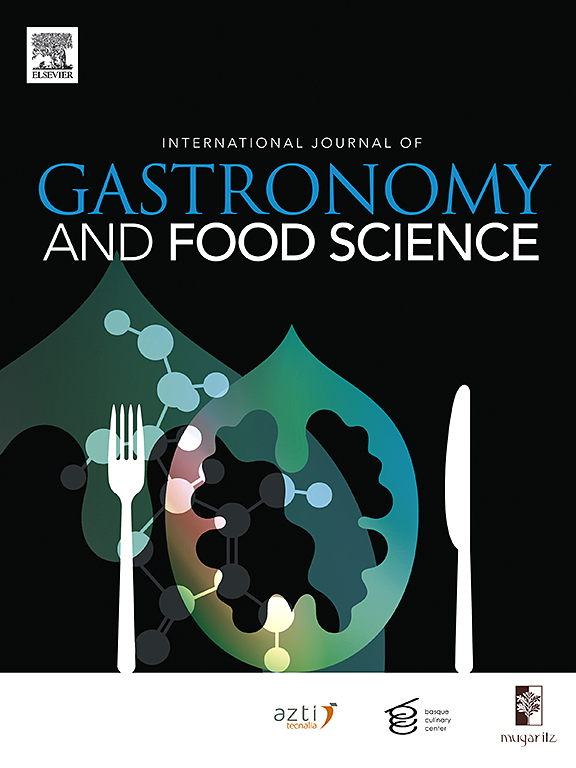The role of frying time in shaping the flavor characteristics of chili rapeseed oil
IF 3.6
2区 农林科学
Q2 FOOD SCIENCE & TECHNOLOGY
International Journal of Gastronomy and Food Science
Pub Date : 2025-06-06
DOI:10.1016/j.ijgfs.2025.101220
引用次数: 0
Abstract
Deep-fat frying is a common technique for preparing a famous Chinese food seasoning, chili rapeseed oil (CRO). This research mainly focused on shaping the flavor characteristics of CROs via different frying times. The results found that as the frying time prolonged, the filtered chili flakes darkened in color, the scores of pungent and dried pepper attributes increased, and the scores of fatty attributes decreased. E-nose found that the W5S, W1W, and W2W sensors were the keys to distinguishing CRO flavors. The HS-GC-IMS technique identified 61 VOCs in different CROs. 20 of these VOCs increased in their concentrations, 7 hardly changed, and 34 decreased in their concentrations as the frying time increased. Different VOCs made their contributions to CRO flavors, and PCA categorized all the samples into 6 types of characteristic flavors. Specifically, CROs with frying times of 1, 2, and 3 min were regarded as three different groups; 4-6 min, 7-8 min, and 9-10 min were categorized as the other three groups. This study offered experimental evidence to elucidate the influence of soaking times in high-temperature oil on CRO flavor.
油炸时间对辣椒菜籽油风味特性的影响
深油炸是一种常见的技术,用于制作著名的中国食品调味料,辣椒菜籽油(CRO)。本研究主要研究了不同油炸时间对cro风味特性的影响。结果发现,随着油炸时间的延长,过滤后的辣椒片颜色变深,辣味和干辣椒属性得分增加,脂肪属性得分降低。电子鼻发现,W5S、W1W和W2W传感器是区分CRO口味的关键。HS-GC-IMS技术鉴定出61种挥发性有机化合物。其中20种挥发性有机化合物的浓度随油炸时间的增加而增加,7种几乎没有变化,34种浓度随油炸时间的增加而降低。不同VOCs对CRO风味的贡献不同,PCA将所有样品分为6种特征风味。具体地说,油炸时间分别为1、2、3 min的cro被视为三个不同的组;4 ~ 6 min、7 ~ 8 min、9 ~ 10 min为其他三组。本研究为阐明高温油中浸泡时间对CRO风味的影响提供了实验依据。
本文章由计算机程序翻译,如有差异,请以英文原文为准。
求助全文
约1分钟内获得全文
求助全文
来源期刊

International Journal of Gastronomy and Food Science
Social Sciences-Cultural Studies
CiteScore
5.30
自引率
10.50%
发文量
170
审稿时长
45 days
期刊介绍:
International Journal of Gastronomy and Food Science is a peer-reviewed journal that explicitly focuses on the interface of food science and gastronomy. Articles focusing only on food science will not be considered. This journal equally encourages both scientists and chefs to publish original scientific papers, review articles and original culinary works. We seek articles with clear evidence of this interaction. From a scientific perspective, this publication aims to become the home for research from the whole community of food science and gastronomy.
IJGFS explores all aspects related to the growing field of the interaction of gastronomy and food science, in areas such as food chemistry, food technology and culinary techniques, food microbiology, genetics, sensory science, neuroscience, psychology, culinary concepts, culinary trends, and gastronomic experience (all the elements that contribute to the appreciation and enjoyment of the meal. Also relevant is research on science-based educational programs in gastronomy, anthropology, gastronomic history and food sociology. All these areas of knowledge are crucial to gastronomy, as they contribute to a better understanding of this broad term and its practical implications for science and society.
 求助内容:
求助内容: 应助结果提醒方式:
应助结果提醒方式:


